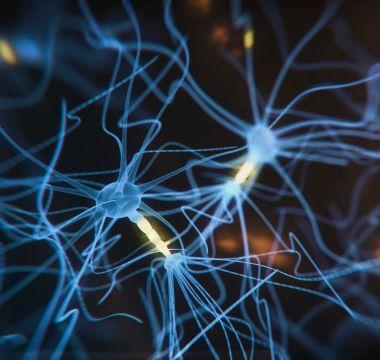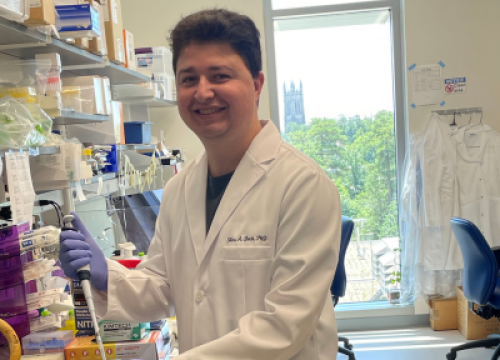A Protein that Protects Against Brain Cell Degeneration Associated with Parkinson’s

Guanylyl cyclase C (GUCY2C) is protective against dopamine neuron degeneration, a hallmark of Parkinson’s, by helping the cell’s powerhouse.
A new study is the first to identify a brain receptor called GUCY2C as a potential way to fight dopamine loss.
Parkinson’s disease (PD) is caused by the death of neurons that produce dopamine — a feel-good chemical related to movement, mood and more — in the brain. Dopamine neurons are involved in movement and the loss of these neurons disrupts the brain's ability to regulate movement, leading to hallmark PD symptoms, such as tremors, rigidity and slowness.
One of the reasons that dopamine neurons die is due to dysfunction of mitochondria, the small oxygen-consuming and energy-producing powerhouses inside cells. Recent research has found a receptor on the surfaces of those Parkinson’s-associated dopamine neurons that may provide therapeutic ways to protect the mitochondria and prevent the progression of the disease.
The receptor, called guanylyl cyclase C (GUCY2C), was first discovered on the surfaces of cells in the intestine, but was recently found in a region of the brain called the substantia nigra pars compacta (SNpc). This area of the brain is affected in PD.
A new study led by Scott Waldman, MD, PhD, and funded by the Parkinson’s Foundation 2023 Impact Award, gives a clearer picture of how GUCY2C signaling can provide protection against mitochondrial dysregulation and dopamine neuron degeneration that leads to PD. According to the study, in people with Parkinson’s, dopamine neurons make extra GUCY2C receptors.
About the Study & Results
Dr. Waldman and his team studied mice with and without the GUCY2C receptor. They found that loss of GUCY2C led to mitochondrial dysfunction, oxidative stress and cell death within the part of the brain impacted by PD, suggesting a protective nature of GUCY2C.
When the researchers gave the two groups of mice a toxin that induces PD symptoms by targeting mitochondria in dopamine neurons, only mice that did not have GUCY2C receptors had higher rates of dopamine neuron death. In contrast, mice with GUCY2C increased their production of the protein upon treatment with the toxin, further indicating a protective role.
The researchers also found that cyclic GMP (cGMP), a byproduct of GUCY2C activation, protected dopamine neurons from oxidative stress. In neurons grown in a petri dish, adding a molecule that increases cGMP protected dopamine neurons from oxidative stress and mitochondrial dysfunction when they added the PD-inducing toxin.
These results indicate that in Parkinson’s disease, the increase in GUCY2C might be the body's attempt to protect dopamine neurons from damage. It may be possible to develop a molecule that targets GUCY2C or use existing drugs that increase cGMP to protect dopamine neurons from damage.

Highlights
- Loss of the receptor GUCY2C led to dopamine neuron degeneration in mice — in other words, not having the GUCY2C receptor led to neuronal dysfunction in brain regions implicated in PD.
- A molecule that increases cGMP (a byproduct of GUCY2C activation) protected neurons grown in a petri dish from mitochondrial dysfunction and cell death when the researchers added a toxin that induces neurodegeneration.
- Because GUCY2C is increased in people with Parkinson’s, the study results suggest that the increase in GUCY2C may be the body's attempt to protect dopamine neurons from damage.
What does this mean?
This study is the first to identify the receptor GUCY2C as a possible defense mechanism against dopamine loss. This research marks the beginning of what can be a new way to significantly slow down the progression of Parkinson’s.
Since GUCY2C appears to protect dopamine neurons in the brain, researchers could explore the possibility of stimulating GUCY2C as a treatment for PD. They could also try increasing cGMP, a byproduct of GUCY2C activation. This could potentially prevent the degeneration of dopamine neurons, a hallmark of the disease.
The study also found that people with PD have high levels of GUCY2C, which may also serve as an early indicator of Parkinson’s.
What do these findings mean to the people with PD right now?
With more research, GUCY2C could be a potential biomarker doctors can use to detect PD earlier. Having access to early biomarkers are critical for early therapeutic interventions for people with PD.
In addition, GUCY2C is a promising therapeutic target to prevent or treat PD. While developing a treatment that targets GUCY2C or its byproducts could take time, it remains important for researchers to identify as many potential treatments as possible. People who are currently experiencing Parkinson’s symptoms should talk to a healthcare provider.
Learn More
The Parkinson’s Foundation believes in empowering the Parkinson’s community through education. Learn more about PD and the topics in this article through our below resources, or by calling our free Helpline at 1-800-4PD-INFO (1-800-473-4636) for answers to your Parkinson’s questions.
- My PD Story: Scott Waldman, MD, PhD – learn more about this study and Dr. Waldman
- Neuro Talk: PD Progression
- Getting Diagnosed
Related Materials
Related Blog Posts

Neuro Talk: What’s Next for PD Research

